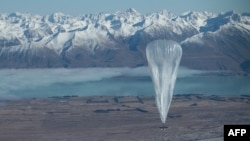Google scientists have launched up to 30 helium-filled test balloons into the skies above New Zealand, with the dream of bringing the Internet to nearly five billion people across the globe without access to the World Wide Web.
The technology giant unveiled the project Saturday in Christchurch, where some 50 volunteer households have begun receiving Internet signals beamed from the balloons to their home computers. The wind-driven balloons are floating 20 kilometers above the earth and are designed to remain airborne for more than three months.
Project leader Mike Cassidy said engineers hope to provide much cheaper Internet connections in undeveloped and developing areas of the world. He cited current Internet costs in large parts of Africa, where monthly access costs are higher than monthly salaries.
Cassidy, speaking to reporters, called the project a "huge moonshot, a really big goal to go after." But he also described the potential results as life-changing for billions of people across the globe.
The initiative, called "Project Loon," was developed in the same top-secret Google X laboratories where scientists are developing the prototype driverless car and Google's web-surfing eye glasses.
Google says the thin plastic, high-pressure balloons hovering over New Zealand carry navigational equipment, solar-powered panels, radios and transmitters. The balloons receive Internet signals from ground stations and then relay those signals to small specialized antennas on rooftops below.
Engineers are also touting the potential benefits of the balloon transmitters in areas that have lost communications because of violent storms and earthquakes.
The technology giant unveiled the project Saturday in Christchurch, where some 50 volunteer households have begun receiving Internet signals beamed from the balloons to their home computers. The wind-driven balloons are floating 20 kilometers above the earth and are designed to remain airborne for more than three months.
Project leader Mike Cassidy said engineers hope to provide much cheaper Internet connections in undeveloped and developing areas of the world. He cited current Internet costs in large parts of Africa, where monthly access costs are higher than monthly salaries.
Cassidy, speaking to reporters, called the project a "huge moonshot, a really big goal to go after." But he also described the potential results as life-changing for billions of people across the globe.
The initiative, called "Project Loon," was developed in the same top-secret Google X laboratories where scientists are developing the prototype driverless car and Google's web-surfing eye glasses.
Google says the thin plastic, high-pressure balloons hovering over New Zealand carry navigational equipment, solar-powered panels, radios and transmitters. The balloons receive Internet signals from ground stations and then relay those signals to small specialized antennas on rooftops below.
Engineers are also touting the potential benefits of the balloon transmitters in areas that have lost communications because of violent storms and earthquakes.






